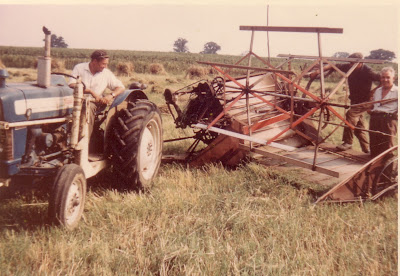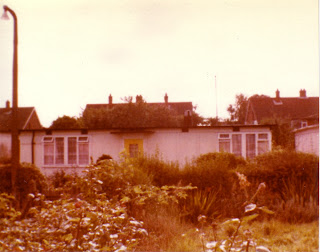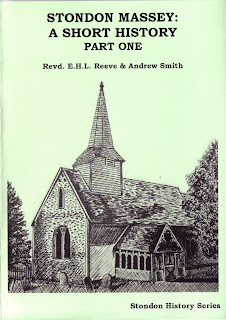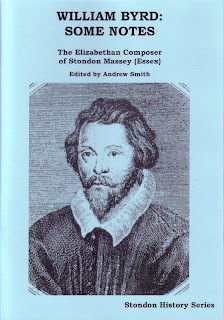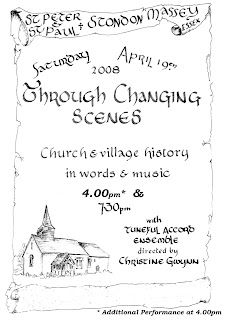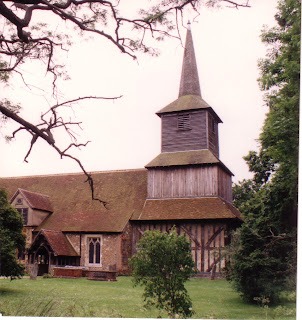
The following is taken from Revd. Alfred Suckling’s book, ‘Memorials of the antiquities and architecture, family history and heraldry of the County of Essex’ (John Weale, London, 1845).
Had we not the concurrent testimony of writers to confirm the fact, it would be natural conclusion, that the public buildings of barbarous nations would be constructed of the same materials as their private dwellings unacquainted with the science which could teach how to shape the rough stone of the quarry, or to raise in air the self-suspended arch, the softer substance of wood at once would offer a more efficient material for the hands it artless workmen. Temples, in honour of their heathen deities, we learn, were so framed previously to the conversion of the Scandinavians, and after that event, their churches were hewn from neighbouring forests; indeed, timber appears to be the material most usually employed by the Northman for this purpose. One very remarkable building thus constructed is yet in existence in Norway – it is the church at Hitterdall, in Lower Tellemark, erected about the twelfth Centurv ; it is reared in balks of fir, now hardened and blackened by time, and decorated with carvings of scales and lozenges. The same fashion prevailed in this kingdom. “There was a time”, says venerable Bede, “when there was not a stone church in all the land, but the custom was to build them all of wood. Finan, the second Bishop of Lindisfarne, of Holy Island, built a church in that island, A.D. 652, for a cathedral, which not yet of stone, but of wood, and covered with reeds”. At York, we learn, the earliest cathedral was constructed of like materials, and a church f stone, erected at Lincoln, by Paulinus, was esteemed not only a prodigy deserving historical mention, but a work of art so wonderful, that healing miracles were wrought by it for the benefit of those whose faith led them to gaze upon it. The Abbey Church of Aethelingey, erected by the great Alfred, and of which the historians of that day speak in rapturous terms, was built only of wood. Edgar the peaceable, who flourished after the middle of the tenth century, observed that, at his accession to the throne, all the monasteries in England were in a ruinous condition, and consisted only of rotten boards and shingles. That this method of constructing sacred buildings was not totally abandoned even at a still later period, is evident from the circumstance that, previously to the foundation of the present cathedral at Salisbury, in the thirteenth century, the first business of the monks was to erect and consecrate a wooden chapel for temporary use.
We are not, however, so much surprised at this method of construction, as astonished at its durability; a very remarkable instance of which presents itself in the little church of Greensted, erected about the year 1013, and whose timber walls remain so strong and sound as to defy conjecture as to their probable duration. It is a mere log-house, built of the trunks of trees, like those described by the Anglo Saxon writers, and was originally erected as a sort of shrine, for the reception of the corpse of St. Edmund, which, on its return from London to Bury St. Edmund’s, in the year 1013, was, as Lydgate, a monk of that monastery, informs us, conveyed in a chest. In a MS. entitled “The Life and Passion of Saint Edmund,” preserved Lambeth Palace, it is recorded, that in the year one thousand and ten, (thirtieth Ethelred,) the body of Saint Edmund was removed to London, on account of the invasion of the Danes, but that at the expiration of three years it was returned to Bedriceworth, (Bury St. Edmund’s, in Suffolk,) and that it was received on its return from London at Stapleford. And in another MS., cited by Dugdale in his Monasticon and entitled “The Register of Saint Edmund’s Burr,” it is further added, “he also sheltered near Aungre, where a wooden chapel remains as a memorial unto day.” The parish of Aungre, or Ongar, herein mentioned, adjoins that of Greensted, where this church is situated, and through which the ancient road from London into Suffolk passed; and no doubt has ever been entertained that this rough and unpolished fabric of oak is the “wooden chapel near Aungre.” A tradition has ever since existed in the village, that the bones of a Saxon monarch once rested in this church; and although tradition does in some cases, as I willingly allow, nourish erroneous opinions, yet when, as in the present case, it is found to be divested of all and conforms itself so exactly to the records of history, and to existing monuments of antiquity, it must be granted to afford very strong additional testimony.
As a view of the church accompanies this notice of Greensted, with a ground plan, and detail of a portion of the edifice, on a large scale, I trust that a few words will suffice to make any one, unacquainted with the building itself, perfectly comprehend its peculiarities and construction. The timber walls, which 1 take to be of oak, though some imagine them to be of chestnut wood, are but six feet in height on the outside including the sill; they are not, as usually described, ‘‘half trees”, but have had a proportion of the centre or heart cut out, probably to furnish beams for the construction of the roof and sills ; the outside or slabs thus left were placed on the sill, but by what kind of tenon they are there retained does not appear; while tile upper ends, being roughly adzed off to a thin edge, are let into a groove, and which, with the piece of timber in which it is Cut, runs the whole length of the building itself; the door posts are of squared timber, and these are secured in the above-mentioned groove by small wooden pins, still firm and strong - a truly wonderful example of the durability of British oak. The wall on the south side, besides leaning a little out wards, inclines somewhat towards the eastward, hut further declension is prevented by the erection of brick buttresses, as these, with a modern porch of wood, in some measure conceal the original face of the south side. I have preferred taking my drawing from the north-west, where nothing intervenes to obstruct a complete view. By a reference to the ground plan it will appear that the east end has been destroyed, to admit access to a more modern chancel, and thus we are unable to determine whether, like most Anglo Saxon churches, this ended in a semicircular sweep. At the west end, a way has been cut to a tower, and here I had an opportunity of examining the very heart of the timber; to the edge of an exceeding good pocket knife it appeared like iron, and has acquired from age a colour approaching to ebony, but of a more beautiful brown; and if any conclusion may be drawn from the appearance of the whole building, I see no reason why it should not endure as long as it has already existed. The outsides of all the trees are furrowed to the depth of about an inch into long stringy ridges, by the decay of the softer parts of the timber, but these ridges seem equally hard as the heart of the wood itself; the north doorway, which measures only four feet five inches in height, by two feet five inches in width, is at present closed with masonry, but the aperture must have been original. It is generally thought that the wood work of the roof is coeval with the walls, and it was most likely formerly covered with thatch, as Bede describes, and as may still be seen on many village churches in the county of Norfolk.
The body of the church is lighted by windows in the roof, but these are decidedly of a recent date; what little light its interior enjoyed in its primitive state was probably admitted from the east end, if any windows existed at all; but if we consider the lawless state of the times, and the sanctity, and consequent value of St. Edmund’s bones, it will not be hazarding a conjecture devoid of reason, to suppose that it was illumined solely by the flame of torches.
How the interior was originally finished, cannot be now determined; at the present moment it is kept in a very neat and reputable state; its walls and ceiling are plastered and whitewashed, and its area affords sufficient accommodation for the population of this parish. Let us hope, that having escaped demolition during the dark ages which have immediately preceded us, no one can be found tasteless enough to meditate its demolition. The chancel is of red brick, and in the style characteristic of the latter days of Henry the Seventh’s reign; at the south-east angle is a piscina of a very unusual fashion, but no other architectural embellishment attracts our attention.
MONUMENTS.
Sacred to the memory of Mary Smith, the deservedly beloved and affectionate wife of Craven Ord, and daughter of John Redman, both of Greensted Hall, Esquires, who, after enduring with Christian fortitude and patience a long and painful illness, calmly resigned her life to Him who gave it, on the 1st day of March, 1804, aged 39 years, leaving a deeply afflicted husband and seven seven children to deplore the irreparable loss of her conjugal affection, her maternal tenderness and her pious example. A tribute of the most tender affection, and an earthly memorial of those virtues which, through her Redeemer’s merits, are recorded in Heaven; this tablet is erected by her ever lamenting husband.
With the arms of Smith:
Here lieth Jone, sister to Sir Thomas Smith of Mont, Knight, second wife of Alune Wood of Snodland in Kent, Gent., who livinge vertuouselie 66 yeeres, died godly the xx of August, 1585.
Prope jacet Richardus Hewyt, A.M., hujus ecclesim quondam rector, in villa Eccles apud Lancastrienses natus, ubi natus etiam fuit celeberrimus ille Theologiae Doctor Johanues Hewyt, qui ob fldcm Carolo 2. exulanto, nefariâ perduellium sententiâ securi percussus est. Richardus patruo tam illustri nepos non indignus obiit 26 April. A.D. 1724.
With the arms of Warren, with an inescocheon:
Underneath lie the remains of the Rev. William Hamilton Warren, A.M., late rector of this parish, who, for 31 years, discharged the duties of his ministry in this place. He departed this life the 9th of November, 1825, aged 64. This small tribute to his memory is placed by his affectionate widow, Sarah Sindry Warren.


